
jean rouch : senegal, 1949
| home | catalogue | history | references | appendix |
 |
surfresearch.com.au
jean rouch : senegal, 1949 |
|
Notes Africaines IFAN (Institut français d’Afrique noire) Dakar, Number 42, Avril, 1949. French text. |
African Notes IFAN (French Institute of Black Africa) Dakar, Number 42, April, 1949. English text. |
An earlier and similar
report by James Edward Alexander in 1835 strongly suggests that surf riding
was an indigenous practice on the coast of West Africa, and unlikely to
be derived from Polynesia.
Further reports,
spaning over 100 years; in The Graphic (1891), and by Rouch
(1949) and Brown (1966); illustrate that juvenile surfboard riding was
an enduring feature of coastal life in West Africa, and these skills were
subsequently employed as adults when boating offshore.
See
James Edward Alexander:
West
Africa, 1835.
The article begins
by attempting to scientifically describe the dynamics of surf riding,
with several explanatory illustrations.
Although he does
not mention it, Rouch is aware of some literature on wave motion, "the
trochoidal theory," and surfboard riding in Hawai'i, Hence his inclusion
of "true surf-riding," riding a 2 meter (6ft 6'') board while standing,
while this is not reported in his observations at Yoff.
Rouch then relates
his observations of surf riding, as "practiced by young fishermen," at
the beach at Yoff.
Located north of
the city of Dakar, the surf is "most favorable ... at high tide," with
rides of fifty meters.
He also reports
that surf riding is practised at St. Louis, 260 km north of Dakar, where
" they are known to ride a hundred meters."
Given his scientific
interest in the dynamics of surf riding, Rouch identifies several beaches
he considers have "very favorable" conditions- on the coasts of Morocco
and France, and at Cambéréne, Yoff, and Madeleines beaches,
adjacent to Dakar.
However, at these
locations surf riding is "almost unknown," although he notes that
he had occassionally seen it on the Basque coast.
Rouch notes that "this game is called 'Saran' (to slide)," a term very similar to Polynesian terminology, for example the Hawai'ian expression "he'e nalu" translates as "wave-sliding".
Whereas the description
of the boards suggest they are relatively crude, "made of an old piece
of wood, a barrel stave, or the bottom of an old canoe," some boards have
clearly been modified with "a transverse bar known as the 'steering wheel',"
and illustrated in Figure 6.
There are several
reports of Pacific islanders using sections of a damaged canoe, or canoe
parts, as a surfboard.
The preference is to catch unbroken waves waves, and style was apparently assessed by the practitioners; for example, riding with one elbow on the board was considered one (of several?) "fantasies."
A short film by Jean
Rouch, Mammy Water (1953-1954), explores traditional water
legends and documents the local fisherman using their boats in the surf
of the Ghana coast, with a bellyboarding sequence appearing in the last
minute of the film (17:00-17:44).
These surfers are
adult males and their narrow timber boards appear to be specifically constructed,
with at least one with a rounded nose.
There is no board
with a "steering wheel," as described and illustrated by Rouch in
the 1949 article.
See :
- vimeo: "Mammy
Water" Jean Rouch (1953)
http://vimeo.com/57445578
Mammy Water -
Mami Water - Mami Wata (Mother Water) are at once beautiful, protective,
seductive, and dangerous water spirits, celebrated throughout much of Africa
and the African Atlantic.
A rich array of
arts surrounds her, as well as a host of other aquatic spirits--all honoring
the essential, sacred nature of water.
Mami Wata is often
portrayed as a mermaid, a snake charmer, or a combination of both.
- National Museumof
African Art
http://africa.si.edu/exhibits/mamiwata/intro.html
Notes by Herve
Magnificat (edited).
The beginning of
the article is a scientific description of catching waves, and Rouch notes
that he has observed this at Yof, the north part of Dakar city, and at
St. Louis, a town 200 km north of Dakar.
The journal was published
in Dakar; Sénégal being a French colony at this time.
Jean Rouch (1917-2004),
was a French film maker, an ethnologist and a photographer who was entranced
by Africa, and living in Senegal at the time of writing.
- wikipedia: Jean
Rouch
http://en.wikipedia.org/wiki/Jean_Rouch
A short movie filmed
by Jean Rouch on the Ghana coast in 1953 (-1955), Mammy Water,
explores the traditional water legends and documents the local fisherman
using their boats in the surf, with a bellyboarding scene appearing in
the last minute of the film.
See :
http://vimeo.com/57445578
In 2002, Ben Finney noted:
"Some years later,
while searching through Harvard University’s extensive library system,
I chanced upon an article by documentary filmmaker Jean Rouch on native
board surfing along the coasts of Senegal and other countries of West Africa.
From the descriptions
in Rouch’s article and from photographs sent to me by a Peace Corps volunteer
that clearly showed young boys riding prone on small boards, it looked
to me that West African surfing was much like paipo surfing.
Yet the first report
of paipo dates back to 1835 (James Edward Alexander’s report), and I found
no evidence that it had spread to West Africa from Hawaii.
Moreover, the West
Africans used crossbars to grip the boards, a feature not found in the
Pacific.
These factors led
me to conclude that West African surfing probably developed on its own."
- Ben Finney: Whoa, dude ! Surfin’ that old ?, in Colburn (et al.): Surf Culture (2002).
This confirms that that juvenile surfing was already a common and enduring practice in West Africa before the arrival of Bruce Brown, as "documented" in The Endless Summer (1966).
For other reports from West Africa, see:
1812 Henry Meredith : Canoe
Surf Riding on Gold Coast, Africa.
1835 James Edward
Alexander :
West Africa.
1861 Thomas J. Hutchinson : Surfboard
Riding in Gabon, Africa.
1876 Hugh Dyer : Surf
Boats in West Africa.
1891 The Graphic
: Surf Boats, Ghana.
1923 Robert Rattray : Padua
at Lake Bosumtwi, Africa.
|
|
|
« Surf-riding sur la côte d’Afrique »
Principe
et description.
Le « surf-riding
» (chevauchée des vagues) est un jeu qui consiste à
se faire pousser par les vagues du large vers la rive.
La théorie
de la houle trochoïdale explique la possibilité d'un tel déplacement.
a) Vague non déferlée
Dans ce cas,
il n'y a pas de mouvement de la surface de la mer, les molécules
étant animées d'un mouvement circulaire dans un plan vertical
mais si un flotteur parvient à se maintenir en équilibre
sur le front de la vague, il sera poussé par celle-ci comme une
bille posée sur un tapis est poussée par l'onde formée
par un crayon que l'on glisse sous ce tapis.
A ce moment,
c'est le poids du flotteur qui peut le maintenir sur le front de la vague,
mais à la condition qu'il puisse glisser sur la surface de celle-ci,
ce principe était appliqué jadis par les péniches
dans certains canaux : par un effort de traction supplémentaire,
elles dépassaient leur propre vague et se faisaient pousser par
l'onde solitaire ainsi formée, la traction n'intervenant plus que
pour maintenir la position d'équilibre.
Ajoutons que
cet équilibre se réalisera plus facilement si l'angle de
front de la vague sur l'horizontale (angle d de la figure 1) est
le plus grand possible, c'est-à-dire par une houle en eau peu profonde
(onde solitaire d'un canal, ou vague arrivant au rivage).
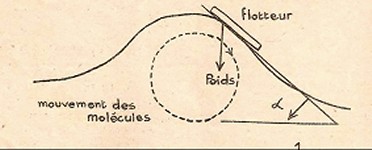
[Image 1]
b) Vague déferlante
Dans ce cas,
il y a un déplacement véritable des molécules d'eau
formant la vague : tout se passe comme si cette tranche d'eau glissait
sur une tranche d'eau inférieure. Si le flotteur parvient à
se maintenir dans la partie active de la vague (front) il sera poussé
jusqu'au rivage.
c) Description
du « surf-riding »
Le jeu consiste
à se servir de ces deux principes, à prendre le plus au large
possible une vague non déferlée et à se faire
pousser par elle jusqu'au déferlement puis au rivage. Cet exercice
peut se pratiquer de différentes façons :
1. Nage
Le nageur démarre
un peu avant que la vague soit sur lui pour être rattrapé
au maximum de vitesse. Si le nageur va à une vitesse à peu
près égale à celle de la vague, il sera poussé
par elle à condition qu'il s'y maintienne par la réaction
(R de la figure 2) des mouvements de bras sur le pied de la vague ; ce
système a l'inconvénient de demander un gros effort et d'être
impossible en petiote profondeurs (inférieures à la longueur
des bras).
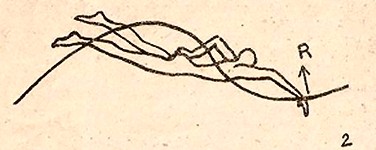
[Image 2]
2. Glissade sans
planche
Le nageur se
lance comme précédemment, mais une fois « pris »,
il s'allonge complètement sur l'eau, la tête entre les bras,
les mains à plat. La réaction sur les mains et les bras glissant
sur le front de la vague non déferlée ou sur la couche d'eau
inférieure sur laquelle se déplace la vague déferlée
permet l'équilibre à condition que la vitesse de la vague
soit assez grande, mais ce système à l'inconvénient
d'empêcher toute respiration et toute vision pendant le parcours.
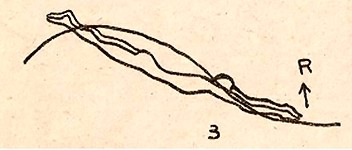
[Image 3]
3. Glissade avec
petite planche
Par contre si
le nageur s'appuie sur une simple planche (0,60 X 0,30 par exemple), la
réaction R (figure 4) verticale est beaucoup plus importante et
permet à la tête (et souvent au buste) d'être entièrement
hors de l'eau. Une fois la vague prise, aucun autre effort n'est plus nécessaire.
Le nageur doit simplement prendre garde à bien orienter sa planche
(inclinée avant le déferlement, presqu'horizontale après)
; il sera poussé jusqu'à l'échouage. De plus, en inclinant
la planche latéralement, le nageur est, dans une certaine mesure,
maître de sa direction.
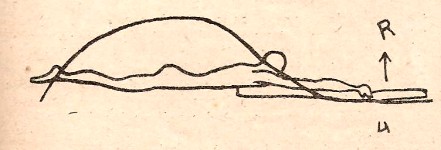
[Image 4]
4. Glissade avec
une grande planche
Avec une planche
de 2 mètres de long, épaisse et légère, le
nageur parvient à se mettre debout, c'est là le vrai «
surf-riding »(figure 5).
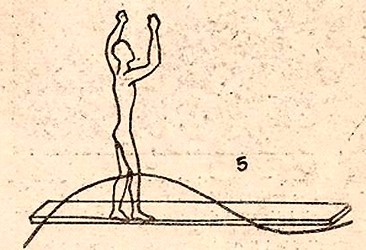
Pratique de ce jeu en Afrique
Nous avons assisté à ce jeu au village de Yof.« Surf-riding sur la côte d’Afrique »
Principe et description.
Le « surf-riding
» (chevauchée des vagues) est un jeu qui consiste à
se faire pousser par les vagues du large vers la rive. La théorie
de la houle trochoïdale explique la possibilité d'un tel déplacement.
a) Vague non déferlée
Dans ce cas,
il n'y a pas de mouvement de la surface de la mer, les molécules
étant animées d'un mouvement circulaire dans un plan vertical
mais si un flotteur parvient à se maintenir en équilibre
sur le front de la vague, il sera poussé par celle-ci comme une
bille posée sur un tapis est poussée par l'onde formée
par un crayon que l'on glisse sous ce tapis. A ce moment, c'est le poids
du flotteur qui peut le maintenir sur le front de la vague, mais à
la condition qu'il puisse glisser sur la surface de celle-ci, ce principe
était appliqué jadis par les péniches dans certains
canaux : par un effort de traction supplémentaire, elles dépassaient
leur propre vague et se faisaient pousser par l'onde solitaire ainsi formée,
la traction n'intervenant plus que pour maintenir la position d'équilibre.
Ajoutons que cet équilibre se réalisera plus facilement si
l'angle de front de la vague sur l'horizontale (angle d de la figure
1) est le plus grand possible, c'est-à-dire par une houle en eau
peu profonde (onde solitaire d'un canal, ou vague arrivant au rivage).
Il est pratiqué
par les jeunes pêcheurs.
Ils pratiquent
la glissade avec la planche.
Celle-ci est
un vieux bout de bois, une douve de tonneau, ou le fond d'une vieille pirogue.
Certaines planches
sont munies d'une barre transversale dite le « volant » (figure
6).
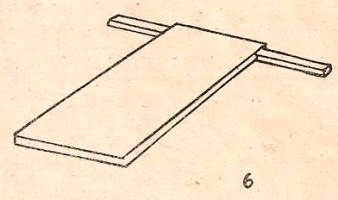
[Image 6]
Les plus habiles
se servent de toutes petites planches et se livrent à des «
fantaisies » (un coude appuyé sur la planche comme sur la
photographie).
Ce jeu s'appelle
« saran » (glisser).
Les indigènes
ont tendance à ne prendre que des vagues non déferlées
(ce qui est beaucoup plus facile) et battent des pieds presque tout le
temps (ce qui ne sert à rien à partir du moment où
la vague est prise).
Ce jeu se pratique
au Sénégal depuis fort longtemps.
A Saint-Louis,
par mer assez dure, on arriverait à parcourir ainsi une centaine
de mètres.
A Yof, à
marée haute (la plus favorable), des trajets de 50 mètres
sont courants.
Le « surf
game » est signalé à Accra par James Alexander («
Colonies of Western Africa ») dès 1837 : « on pouvait
voir pendant ce temps dans la baie des garçons nageant dans la mer,
des planches légères sous
Page 52
leur estomac.
Ils attendaient
une vague, et alors ils venaient en roulant dedans… »
Il serait intéressant
de rechercher l'origine en Afrique de ce jeu, qui, quoique très
simple, n'est pas très instinctif.
Ainsi, il est
à peu près inconnu sur la côte du Maroc (cependant
très favorable), parmi les Européens de Dakar (qui peuvent
le pratiquer à Camberène, à Yof ou plus simplement
à la plage des Madeleines) et en France.
Je ne l'ai vu
pratiqué que de façon sporadique sur la côte basque.
»
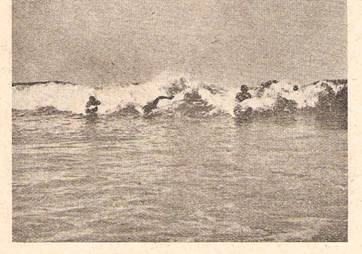
Page 5x
"Surf-riding on the coast of Africa"
Principle
and description.
The "surf-riding"
(ride waves) is a game that is being pushed by large waves to shore.
The trochoidal
wave theory explains the possibility of such a move.
a) Non-breaking
Wave
In this case,
there is no movement of the sea surface, the molecules are moving in a
circular motion in a vertical plane, but if a float manages to maintain
balance on the front of the wave, it will be pushed by the latter as a
ball placed on a mat is pushed by the wave formed by a rod that slides
in this mouse.
At this point,
the weight of the float can keep it on the front of the wave, but on condition
that it can slide on the surface of it, this principle was applied once
by barges in some channels : for additional traction, they exceeded their
own wave and were pushed from the solitary wave thus formed, traction not
intervening to maintain the equilibrium position.
Adding that this
balance will be achieved more easily if the angle of the wave front on
the horizontal (Figure 1) is the largest possible, that is to say by a
wave in shallow water (solitary wave in a channel or wave reaching the
shore).

[Image 1]
b) Surf
In this case,
there is a real movement of water molecules forming the wave: it is as
if the water layer slipped on a slice of bottom water.
If the float
is able to remain in the active part of the wave (front) will be pushed
to shore.
c) Description
of "surf-riding"
The game is to
use these two principles to ride the non-breaking and breaking wave, all
the way to shore.
This exercise
can be done in different ways:
1. Swimming
The swimmer starts
a bit before the wave is on him, to be caught up by its speed.
If the swimmer's
speed is approximately equal to that of the wave, they will be pushed forward,
provided they remain in position by reacting (R in Figure 2) with arm movements
at the foot of the wave, this system has the disadvantage of requiring
a great effort (and is impossible in depths of less than the length of
the arm).

[Image 2]
2. Without sliding
board
The swimmer starts
as before, but once "caught", they lie completely on the water, head between
arms, hands flat.
The reaction
on the hands and arms sliding on the front of the unbroken wave unfurled
or not, the water layer below on which the wave moves unfurled allows balance
provided that the speed of the wave is large enough, but this system restricts
breathing and vision.

3. Ride with small
board
By contrast,
if the swimmer has a simple board (0.60m X 0.30m for example), the vertical
reaction R (Figure 4) is much
greater and allows
the head (and often the body) to be entirely out of the water.
Once the wave
breaks, no further effort is necessary.
The swimmer must
simply be careful to orient the board (inclined before the flood on the
horizontal, below) and will be pushed to the shore.
Furthermore,
by tilting the board sideways, the swimmer is in, to some extent, control
its direction.

[Image 4]
4. Ride with a
large board
With a board
of 2 meters long, thick and light, the swimmer is able to stand up, this
is the true "surf-riding" (Figure 5).

[Image 5]
Practice of this game in Africa.
We have seen this
game in the village of Yof.
It is practiced
by young fishermen.
They practice
the sliding with a board.
This is either
made of an old piece of wood, a barrel stave, or the bottom of an old canoe.
Some boards are
equiped with a transverse bar known as the "steering wheel" (FIG. 6, see
below).

[Image 6]
The most skillful
ones use very small boards and do "fantasies" (one elbow on the board as
in the photograph).
This game is
called "Saran" (to slide).
The natives prefer
to catch unbroken waves waves (which is much easier) and beat their feet
almost all the time (which is useless from the point where the wave is
taken).
This game is
played in Senegal for a long time.
In St. Louis,
by rough sea, they are known to ride a hundred meters.
At Yof at high
tide (most favorable) 50 meters ride are common.
The "surf game"
is reported in Accra by James Alexander ("Colonies of Western Africa")
in 1837, "From the beach, meanwhile, might be seen boys swimming into the
sea, with light boards under
Page 52

their stomachs.
They waited for
a surf; and then came rolling in like a cloud on the top of it. "
It would be interesting
to investigate the origin of the game in Africa, which, although very simple,
is not very instinctive.
Thus, it is almost
unknown on the coast of Morocco (though very favorable), among Europeans
community of Dakar (who can practice at Cambéréne, at Yof
or simply on Madeleines beach), and in France.
I have only seen
it practiced from time to time on the Basque coast.
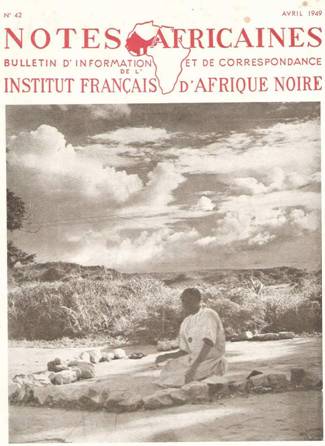 |
Notes Africaines IFAN (Institut français d’Afrique noire) Dakar, Number 42, Avril, 1949. Located and translated
by
|

| home | catalogue | history | references | appendix |